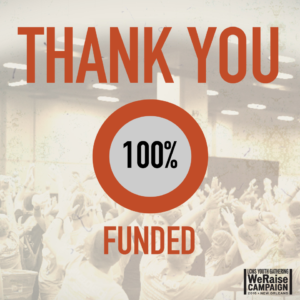For the average person, giving $25,000 towards a cause – even a worthy one – is unrealistic. However, when hundreds of average people give $5-$25 towards a cause, efforts multiply making the seemingly impossible, possible. It’s a humbling, inspiring thing to experience. Welcome to the world of crowdfunding.
Crowdfunding is by definition, “the practice of funding a project or venture by raising many small amounts of money from a large number of people, typically via the Internet.” While the platform might be new, crowdfunding utilizes similar basic principles of traditional fundraising.
Crowdfunding doesn’t magically attract all compassionate people from around the world that have plastic burning in their pockets and inspire them to give generously towards your cause. It is, however, a way to “rally the troops” near and far and provide them a way to contribute towards something bigger than themselves, and thus witness the impact of individual and communal giving.

I witnessed this kind of giving effort last month when the LCMS Youth Gathering launched a crowdfunding campaign to raise $25,000 towards a food packing servant event to take place at the 2016 Gathering. As a facilitator of the campaign, I learned lessons in optimal content strategy and development, scheduling, timing, and positioning. Technique is all well and good. However, one lesson I learned is worth far more than all the rest: It’s not what you know, it’s who you know.
Some call this the secret to life. I believe it’s also the secret to crowdfunding.
The success of a crowdfunding campaign is directly determined by the quality of the social spheres or networks of those involved. There are several layers to this ripple effect. I’ll highlight two:
- What is the weight of influence of those running the campaign? To what spheres of influence (networks) do they have direct access? What people are involved in those networks? How are they connected to the cause? Why do, or should, they care? This is your first layer of support, be it financial or otherwise. Its commitment to the campaign’s success is vital.
- After looking at your own social resources (your connections to other people), what spheres of influence can you tap through others? Identifying key “stakeholders” who are passionate about your cause and can spark passion in groups of people outside your direct sphere of influence is crucial. Much of our success directly resulted from the efforts of stakeholders. These partners acted as spokes connected to the cause but able to extend outwards at differing yet specific angles. This broadened our reach and expanded the pool of potential givers.
At the end of the day, crowdfunding still boils down to people asking people for financial assistance. Whether “the ask” is delivered by an organization, ministry or an individual representing a larger cause, a meaningful relationship between the two parties is still required for an individual to act upon the request.
Social media’s greatest amenity lies in the ongoing, personal relationships it facilitates (and that often extend outside of these platforms as well). Both before and after a campaign, we must be willing to invest in our most valuable resource: interpersonal relationships with others. The success of crowdfunding is the result of these ongoing, real relationships.
Research shows that 93% of consumers/donors trust their peers while only 14% trust advertisements.[i] Without first developing relationships with others, launching a crowdfunding campaign is no more than merely blasting people with ads. People want to help real people. This means we must live out our call to act as neighbors both in season and out of season.
Know your people resources. But more importantly, know your people.
Questions to reflect upon:
- Who are the key influencers in your networks?
- What networks do they have established relationships within that you don’t?
- How is your ongoing, real relationship with these people?
[i] https://www.linkedin.com/pulse/social-media-marketing-trends-statistics-forecast-komal-chauhan